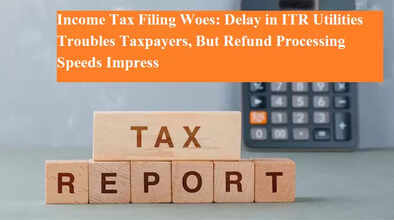Income Tax Filing Woes: Delay in ITR Utilities Troubles Taxpayers, But Refund Processing Speeds Impress

Despite delays in the release of Income Tax Return (ITR) filing utilities, the Income Tax Department has significantly improved the return processing time this year. While taxpayers and Chartered Accountants (CAs) are struggling with technical glitches and inaccuracies in AIS data, the efficiency of refund disbursements has offered some much-needed relief.
Delay in ITR-2 and ITR-3 Utilities Leaves CAs Scrambling
The ITR-2 utility was officially released on July 18, giving clarity to taxpayers who were waiting to file returns using this form. However, CAs are expressing concern over the delayed availability of ITR-2 and ITR-3 utilities. Normally, with the July 31 deadline, they had enough time to complete related tax processes. But now, with just about 60 days left before the extended deadline of September 15, 2025, the workload for tax professionals has surged drastically.
The delay has especially affected those using ITR-2 and ITR-3, which are typically used by individuals with capital gains, multiple income sources, or business and professional income. Due to the late release, professionals are facing a time crunch and increased pressure as they head toward the September 30 deadline for completing various compliance tasks.
AIS Data Errors Compounding the Problem
Another critical issue adding to the burden is the inconsistency found in the Annual Information Statement (AIS). Chartered Accountant Nitesh Budhadev, founder of Nimit Consultancy, highlighted a case where one client was shocked to see a credit card payment of ₹83 lakh reflected in their AIS — an amount far exceeding their credit limit of ₹2.5 lakh. Such discrepancies can mislead taxpayers and, if not corrected, may trigger scrutiny or inaccurate return filings.
In another case, Budhadev mentioned a joint property sale where the entire transaction value appeared under both owners’ AIS entries. Despite submitting feedback clarifying the duplication, the response from the system claimed that the source information was correct — showcasing the system’s current limitations in addressing user-reported anomalies.
CAs Urge Taxpayers to Cross-Verify AIS Before Filing
Given the growing number of AIS-related errors, CAs are strongly advising taxpayers to carefully review their AIS data before using it for return filing. If any inconsistency is found, it’s essential to file a correction or feedback immediately to avoid incorrect returns. Relying blindly on faulty AIS data could lead to tax notices or future complications.
ITR-2 Utility Still Has Issues Post-Release
Even after the ITR-2 utility was made available, it hasn't been entirely error-free. CA Himank Singla pointed out a critical glitch — when claiming the Section 87A rebate, the system is calculating the education cess on gross tax liability instead of net liability after rebate. Such technical flaws can result in taxpayers overpaying if not noticed and manually corrected.
On the Bright Side: Processing Time is Impressively Quick
Despite all these hurdles, one area where the Income Tax Department has scored big is in the quick turnaround of return processing. Taxpayers who filed using ITR-1 and ITR-4 (Sahaj and Sugam forms) have reported receiving refunds within days of filing. According to Singla, the Centralized Processing Centre (CPC) in Bengaluru has significantly reduced its processing time this year.
This faster processing, especially for simple returns, reflects a welcome improvement over previous years. It not only enhances taxpayer confidence but also encourages early compliance.
Final Word: Accuracy is Key Before Speed
While the speed of refund processing is commendable, the accuracy and reliability of AIS data and utility functions remain a pressing concern. Taxpayers and professionals alike must remain vigilant. Review every detail, cross-verify with personal financial records, and file corrections where needed. The extended deadline offers a buffer, but only proactive steps can ensure smooth, hassle-free compliance.

